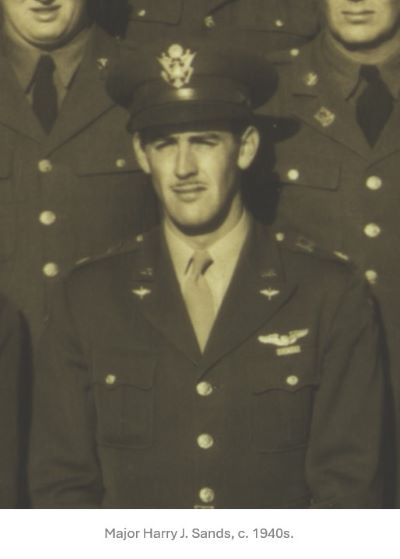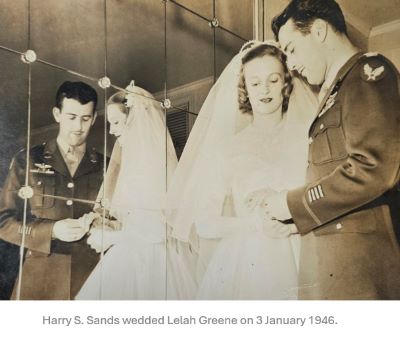The Sands Space History Center bears the name of an individual influential in its creation – Major General Harry J. “Bud” Sands, Jr. He served for many years in America’s space and defense missile programs. General Sands was also instrumental in the creation of the Air Force Space Museum (now Cape Canaveral Space Force Museum) in the 1960s. His dedication toward the preservation and presentation of the Cape’s rich aerospace history is exemplified today by the Sands Space History Center.

Gen Sands through the years
Service & Ranks
2d Lt, Sig Res 13 Jun 1938
Enl, US Army 26 Jun 1939
2d Lt, Air Corps Reserve 23 Mar 1940
1st Lt, Army Air Corps 2 Apr 1942
Capt, Army Air Corps 20 July 1942
Maj, Army Air Corps 7 Sept 1942
Lt Col, Army Air Corps 22 June 1943
Capt, US Army 27 Jan 1944
1st Lt, Air Corps Reserve 1 July 1944
Col, Army Air Corps 24 July 1944
Lt Col, US Army 1 July 1947
Lt Col, US Air Force 30 June 1948
Maj, US Air Force 3 Sept 1948
Col, US Air Force 22 Nov 1948
Lt Col, US Air Force 12 Apr 1951
Col, US Air Force 26 April 1961
Brig Gen, US Air Force 1 Aug 1961
Maj Gen, US Air Force 1 July 1965
Decorations and Medals
Air Medal with 1 Oak Leaf Cluster
American Campaign Medal
American Defense Service Medal
Asiatic-Pacific Camp Medal with seven bronze stars
World War II Victory Medal
National Defense Service Medal with one bronze star
Air Force Longevity Service Award Ribbon with 1 Silver Oak Leaf Cluster
Philippine Liberation Ribbon
Philippine Independence Ribbon
Philippine Republic Presidential Citation
Distinguished Unit Citation Emblem
Navy Unit Commendation Emblem
Legion of Merit
Air Force Outstanding Unit Award Ribbon
Air Force Commendation Medal
Harry J. “Bud” Sands, Jr.
Harry James Sands, Jr., was born in Columbus, Ohio, on 14 October 1915, of parents Harry and Kathleen Sands. After high school graduation, he attended Ohio State University, where he earned a Bachelor of Science degree in Mechanical Engineering in 1938. Sands entered Aviation Cadet training in June 1939 and received his wings in March 1940.
World War II then plunged the United States into combat in two theaters. Sands went to the Pacific Theater, where he was assigned to activate and command the 403rd Troop Carrier Group. Later in the war, Sands became Deputy Commander of the South Pacific Combat Air Transport Operation.
Imperial Japan surrendered in August 1945 and Sands found himself reassigned the following month to the Engineering Division of the Air Materiel Command at Wright Field, Ohio. Sands served among other early American missile development pioneers in the Pilot-less Aircraft Branch. He ascended to Chief, Guided Missile Section, Air Research and Development Command. In 1946, he married Lelah Adeline Green and the two would raise a family of four boys. In 1950, Sands was named Assistant Chief of Development for Aircraft and Missiles at the Research and Development Command headquarters in Baltimore, Maryland.
A transfer in 1953 brought Sands and his family to a more tropical setting – Patrick Air Force Base, Florida. It was located on the grounds of the former Banana River Naval Air Station from World War II. America’s new space and missile programs brought it back to life and activated the Air Force Missile Test Center to the north, now known as Cape Canaveral Space Force Station.
His stay was brief. In 1956, Sands attended the Advanced Management Program at Harvard University and then the Industrial College of the Armed Forces in Washington, DC, the following year. Following that, Sands was reassigned to command of the 38th Tactical Missile Wing in Europe from 1958 to 1961.
An appointment to Brigadier General on 14 July 1961 brought him back to Florida’s Space Coast as Vice Commander of the Air Force Missile Test Center. He became Commander of the Air Force Eastern Test Range on 2 January 1964. During his stay, he coordinated hundreds of milestones and iconic launches from Cape Canaveral. Everything from Project Mercury orbital flights to Polaris submarine missile tests launched during his period of leadership.
He was presented with his second star as Major General on 19 July 1964, when he became Commander, Ballistic Systems Division. It involved reassignment to Norton AFB in California. President Lyndon Johnson appointed Major General Sands senior member of the United Nations Armistice Commission in Korea in October 1965 for a six-month period. Upon his return, he served as Commandant of Air University at Maxwell AFB for a brief period. Major General Sands retired soon after. He volunteered many hours as a volunteer docent at the Air Force Space & Missile Museum, donning a modest name tag with “Bud” printed on it.
Sands stayed busy in retirement. He served as chairman of the United Way of Brevard County and a board member of Landmark Bank. In 1970, Sands was appointed to serve as a special assistant to the governor in promoting space operations for Florida’s Space Coast. During that three-year appointment, Sands was instrumental in securing the space shuttle program for the region. He spent time as an appointee to the Central and Southern Florida Flood Control District. Sands helped found the United States Air Force Space and Missile Museum Foundation in 1991 to help support the mission of the Air Force Space & Missile Museum. Today it’s the U.S. Space Force Historical Foundation, Inc., which continues to provide essential support for the Cape Canaveral Space Force Museum.
General Sands & the Museum
At the conclusion of World War II in 1945, then Colonel Sands began his military career in pilot-less bombs, or guided cruise missiles. Over the next eight years he amassed an exhaustive knowledge of early ballistic missile and winged cruise missile development.
Col Sands connection with Florida’s Space Coast began in March 1953, with his appointment to the Air Force Missile Test Center. In that role, Col Sands helped award the Eastern Range’s first range contract in December of that year. He ascended to Commander of the 6550th in July 1955 and subsequently served as deputy commander of tests through August 1957
When Col Sands returned as vice commander of the Eastern Range in 1961, he proposed a future space museum at Launch Complex 5/6. NASA launched America’s first astronaut into space from that complex in May of that year. Launch Complex 26, site of America’s first satellite launched into orbit, also came under consideration.
In 1963, Maj Gen Leighton Davis (commander of the Eastern Range) appointed Brig Gen Sands to chairman of a museum committee. The goal was to establish an Air Force Space Museum at Cape Canaveral. A collection of rockets, missiles, and support hardware was amassed, but lack of funding scaled back the plans. Gen Sands became the commander of the Eastern Range in 1964 and a historical driving tour of Cape Canaveral began.
A perimeter road around the museum grounds opened for drive-through tours in August 1966. Parking lots opened in May 1967, for walk-around tours, and in 1968 the LC-26 Blockhouse opened to the public. It was around this time that Gen Sands retired as commandant of the Air Command Staff College at Maxwell AFB in Alabama.
Gen Sands commitment to the museum remained into retirement. He volunteered to give tours in the early 1990s. In 1989, he helped establish the U.S. Air Force Space and Missile Museum Foundation as a private, non-profit organization to support the museum’s mission. The kick-off included a $4 million fundraising program to help restore and preserve the artifact collections. Gen Sands championed a museum annex outside the south gate to the installation, to make the aerospace history of the Cape more accessible to the public. He never lived to see it materialize.
Gen Sands died on 26 May 1993 but his vision continued. The Air Force Space & Missile History Center opened on 13 August 2010 outside the south gate. The effort garnered an Air Force Space Command Heritage Award and a USAF Heritage Award. In honor of Gen Sands’ commitment to this effort, the facility was renamed the Sands Space History Center in 2016. Since then, hundreds of thousands of visitors have taken in the inspirational history of America’s space and missile programs within. Today it serves as a multi-use facility for exhibits, special events, military ceremonies, and educational outreach for the Cape Canaveral Space Force Museum.




